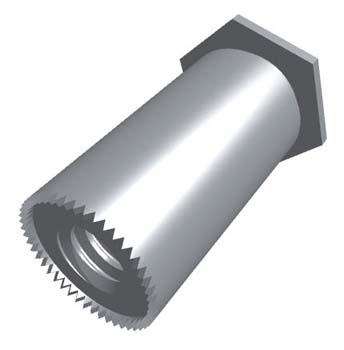Self-Clinching Grounding Standoffs
In this guide, we will explore the world of these innovative and reliable fastening solutions that provide a secure and effective method for electrical grounding in various applications. Self-clinching grounding standoffs, also known as self-grounding standoffs, are designed to be permanently installed in metal sheets or panels to create a reliable electrical connection for grounding purposes.
Key Features and Benefits
Self-clinching grounding standoffs offer a wide range of features and benefits that make them essential components for electrical grounding applications. Let's explore some of their key advantages:
- Electrical Grounding: These standoffs are specifically designed to create a solid electrical ground connection in metal assemblies, ensuring safety and proper functioning of electronic devices.
- Secure Attachment: Once installed, self-clinching grounding standoffs create a strong and permanent connection, providing a reliable grounding point.
- Effective Shielding: Grounding standoffs help dissipate static charges and electromagnetic interference, protecting sensitive electronic components from damage.
- High Conductivity: These standoffs are made from high-conductivity materials, such as brass or copper, to ensure low resistance for efficient grounding.
- Space-Saving: Self-clinching grounding standoffs have a low-profile design, optimizing space in compact assemblies.
- Simple Installation: The installation process involves pressing the standoff into a pre-punched hole, eliminating the need for additional hardware or tools.
- Versatile Applications: These standoffs are used in electronics, telecommunications, aerospace, automotive, and various other industries where electrical grounding is essential.
- Materials and Finishes: Self-clinching grounding standoffs are available in various materials, including brass and copper, with optional plating or coatings for enhanced performance in different environments.
- Cost-Effective: These standoffs streamline the assembly process, leading to increased efficiency and reduced labor costs.
Types of Self-Clinching Grounding Standoffs
Self-clinching grounding standoffs come in different styles and sizes to accommodate various application requirements. Some common types include:
- Round Grounding Standoffs: These standoffs have a round shape and are commonly used in applications where a low-profile and flush appearance is desired.
- Hexagonal Grounding Standoffs: These standoffs have a hexagonal shape, allowing for easy installation using standard tools like wrenches or sockets.
- Blind Grounding Standoffs: These standoffs have a closed bottom end, making them ideal for applications where the bottom side of the panel is not accessible.
- Thru-Hole Grounding Standoffs: These standoffs have a threaded shank that extends through the panel, providing a threaded post on both sides for easy attachment of grounding wires.
Applications
Self-clinching grounding standoffs find numerous applications across various industries due to their reliable and effective grounding capabilities. Some common applications include:
- Electronics: Used in PCBs, electronic enclosures, and racks for grounding sensitive components and devices.
- Telecommunications: Found in networking equipment, data centers, and communication devices to ensure proper grounding and protection against electrical surges.
- Aerospace and Aviation: Used in avionics, cabin electronics, and aircraft panels for critical grounding in high-altitude and harsh environments.
- Automotive: Found in automotive assemblies for grounding electronic control units (ECUs) and other electrical components.
- Industrial Machinery: Utilized in control panels, motor drives, and automation systems to maintain a reliable electrical ground.
- Renewable Energy: Used in solar panels and wind turbines to provide effective grounding for electrical systems.
- Medical Devices: Found in medical equipment and devices to ensure patient and operator safety through proper grounding.
Installation Process
The installation of self-clinching grounding standoffs is a straightforward process that involves the following steps:
- Preparation: Ensure that the panel has the correct hole size and design for the specific standoff.
- Insertion: Insert the standoff into the pre-punched hole.
- Application of Force: Using a press or installation tool, apply sufficient force to the standoff to clinch it securely into the panel material.
- Verification: Confirm that the standoff is correctly installed and providing a secure grounding point.
Quality Assurance and Certifications
At OneMonroe, we prioritize quality and reliability in every self-clinching grounding standoff we produce. Our manufacturing processes adhere to stringent quality standards, and our experienced team of engineers and technicians ensures that each standoff meets or exceeds industry specifications. We are committed to providing products that you can trust for your critical grounding applications.
Conclusion
In conclusion, our Self-Clinching Grounding Standoffs provide a secure and efficient solution for creating reliable electrical grounding connections in various applications. With their self-clinching design, these standoffs offer easy and permanent installation into metal sheets, ensuring stable grounding points without the need for additional hardware. Experience the convenience and reliability of our Self-Clinching Grounding Standoffs by incorporating them into your electrical and electronic assemblies today.










